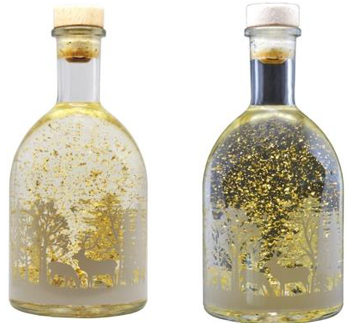The High Court have handed down the hotly anticipated judgment in the case of Marks and Spencer PLC v Aldi Stores Limited, finding that Aldi had infringed M&S’s registered designs. As well as a reminder of how the court assesses registered design infringement, it shows the value of using designs to prevent having to rely on passing-off.
Background
The focus of this claim was M&S’s Christmas, gin-based liqueurs. The gin liqueur was in clear, festively decorated, bottles which had an LED light in the base. The gin liqueur contained gold flakes, so that when the bottle was shaken it appeared to be snowing. The design of this bottle was protected by five registered designs, which showed photographs of the bottle in various states e.g., with the LED light illuminating the bottle and with the gold flakes shaken.

(two of M&S’s registered designs)
In November 2021, Aldi also started to sell gin-based liqueurs containing gold flakes, in a light-up bottle that also featured a winter scene.

(Aldi gin bottles)
M&S brought a claim alleging that by advertising and selling these gin liqueurs, Aldi had infringed their registered designs.
The law
Under the Registered Designs Act 1949, the owner of a registered design has the exclusive right to use the design (e.g. making and putting on the market products which contain the design) as well as any design which does not produce a different overall impression on the informed user. So a design would infringe a registered design if it does not produce a different overall impression on the informed user.
The assessment
The judge analysed:
- The products’ sector (spirits and liqueurs in the UK);
- The (notional) informed user (UK consumer of spirits and liqueurs); and
- The amount of design freedom (which was deemed to be considerable),
Before comparing the registered designs (rather than the M&S bottle as sold) with the Aldi bottle.
The judge held that the following similarities would appear significant to the informed user, and that “cumulatively they would be striking”:
- The identical shape of the bottles;
- The identical shape of the bottle stoppers;
- The winter scene around the bottles, which consist mostly of tree silhouettes;
- The snow effect; and
- An integrated light.
The differences (including the branding on the Aldi bottles) would not produce a different overall impression and so infringement was found.
What does this mean?
Aldi plan to appeal the decision, so the gin may remain on ice for M&S. For now at least, rightsholders will cheer (sorry) this decision as it is an example of a lookalike being found to have infringed. When designing a new product, brands should consider registered designs as a useful tool in their armoury, to offer them protection beyond that provided by the law of passing-off.
 unknownx500
unknownx500









